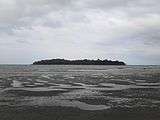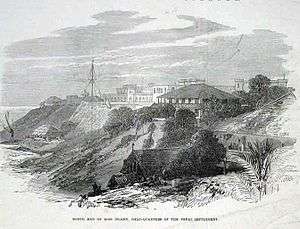Ross Island (Andaman)
 Ross Island Location of Ross Island | |
| Geography | |
|---|---|
| Location | Bay of Bengal |
| Coordinates | 11°40′30″N 92°45′43″E / 11.675°N 92.762°ECoordinates: 11°40′30″N 92°45′43″E / 11.675°N 92.762°E |
| Archipelago | Andaman Islands |
| Adjacent bodies of water | Indian Ocean |
| Total islands | 1 |
| Major islands |
|
| Area | 0.312 km2 (0.120 sq mi)[1] |
| Length | 1.25 km (0.777 mi) |
| Width | 0.52 km (0.323 mi) |
| Coastline | 3.20 km (1.988 mi) |
| Highest elevation | 45 m (148 ft)[2] |
| Administration | |
| District | South Andaman |
| Island group | Andaman Islands |
| Island sub-group | Port Blair Islands |
| Tehsil | Port Blair |
Largest settlement |
INS Jarawa quarters |
| Demographics | |
| Demonym | Hindi |
| Population | 10 (2011) |
| Pop. density | 32 /km2 (83 /sq mi) |
| Ethnic groups | Hindu, Andamanese |
| Additional information | |
| Time zone | |
| PIN | 744101[3] |
| Telephone code | 031927 [4] |
| Official website |
www |
| ISO Code | IN-AN-00[5] |
| Literacy | 84.4% |
| Avg. summer temperature | 30.2 °C (86.4 °F) |
| Avg. winter temperature | 23.0 °C (73.4 °F) |
| Sex ratio | 1.2♂/♀ |
| unit_pref | Metric |
| Census Code | 35.639.0004 |
| Official Languages | Hindi, English |
Ross Island is an island of the Andaman Islands. It belongs to the South Andaman administrative district, part of the Indian union territory of Andaman and Nicobar Islands.[6] the island is lying 3 km (2 mi) east from downtown Port Blair.
History
Early History
After Archibald Blair's survey of the Andaman and Nicobar Islands in 1788, a settlement was established at present day Port Blair (then called Port Cornwallis). In 1792 it was shifted to northern harbour (present day Diglipur) which was also Christened Port Cornwallis (the former became Old Harbour). But, that settlement was abandoned in 1796 as the mortality rate was very high. Between 1789-92, Blair was said to have established a hospital and a sanatorium at Ross Island.
Penal Settlement Period
Six decades later, the 1857 Revolt forced the British to turn to Andaman again. Ever since Dr. James Pattison Walker arrived in Port Blair aboard the East India Company’s steam frigate ‘Semiramis’ on 10 March 1858, this island remained under British occupation till 1942. Ross Island was the Administrative Headquarters for the islands for 85 years before an earthquake rocked it in 1941. One can see remnants of an opulent past in the ruins of the bazaar, bakery, stores, water treatment plant, church, tennis court, printing press, secretariat, hospital, cemetery, swimming pool, the Chief Commissioner’s residence with its huge gardens and state grand ballrooms, the Government House, the old 'Andamanese Home',[7] Troop Barracks, all in dilapidated condition, reminiscent of the old British regime. In November 1857, the Government decided to establish a penal settlement in Andaman and send "hard-core elements" among those who took on the British. There were two reasons: One, to keep them away from other prisoners and the other, to send out a message that a similar treatment would be meted out to anyone who challenged the British authority. In January 1858, the British took possession of three islands in and around Port Blair and Captain H. Man, Executive Engineer, hoisted the Union Jack flag. In March, J.P. Walker, an experienced jail superintendent, arrived in Port Blair with four European officials, an Indian overseer, two doctors, 50 naval guards and 773 freedom fighters. Writer Gauri Shankar Pandey, who belongs to a family that had suffered torture during the Japanese occupation of the Andaman and Nicobar Islands, has documented that it was water scarcity that had driven Walker out of Port Blair and go to Ross Island.
Named after the marine surveyor Sir Daniel Ross, the Island soon became the base. Initially, crude barracks of bamboo and grass were put up for freedom fighters while the rest of the party stayed on board the ships that had brought them. Later, the freedom fighters built houses, offices, barracks and other structures at the Ross Island, after which they were promptly sent to Viper Island, where the first jail was built. The bungalow, meant for the chief of the Penal Settlement, was constructed at the northern summit of the Island. Called Government House, the large-gabled home had Italian tiled flooring on the ground level. Now, some remains of the flooring are there, of course in a decrepit condition.
In 1872, the post of Superintendent was elevated to the level of Chief Commissioner and Sir Donald Martin Stewart, who was at Ross Island for one year, was made the first Chief Commissioner. Stewart held the post from July 1872 to June 1875.
After Stewart, Ross Island saw 24 chief commissioners. But, it was during the tenure of Sir Charles Francis Waterfall that the Island's position as the seat of power collapsed.
Waterfall, who became the Chief Commissioner in 1938, was captured by the Japanese in March 1942 when the latter invaded the Andaman and Nicobar Islands during World War II. He was held as a prisoner of war and his deputy, Major Bird, was beheaded by the Japanese at a clock tower in Aberdeen, Port Blair.
1941 Earthquake
About nine months before the Japanese take-over of the entire set of islands, Ross Island experienced an earthquake, which caused many people to leave the Island. Except for a brief time when the Japanese occupied, the abandonment of Ross Island as a result of the quake continued. The headquarters were then shifted to Port Blair.
Japanese Period
From 1942 to 1945, the island was under the occupation of Japan. The Government House became the residence of the Japanese admiral also for three years (from March 1942 to October 1945). It was during this period that Netaji Subhas Chandra Bose, who took the help of Japanese in his fight against the British, stayed at the Island for a day in December 1943. Netaji also hoisted the national tri-color at the top of the Government House. The Japanese too left their imprint on the island which stood in the form of bunkers. The bunkers were used as watch points to safeguard the Island from any foreign invasion.
Island Recapture
The allies reoccupied the island in 1945 and later abandoned it.
Indian naval post
In April 1979, the island was handed over to the Navy, which set up a small post, INS Jarawa, named after one of the indigenous tribes of the Andaman group of islands.
Tourism Spot
In December 1993, a museum was established on the island. It was declared open by the then Lt. Governor Vakkom Purushothaman. A small guesthouse has been put up for the Navy officers. In 2014, the Government have started Light and Sound Show in Ross Island.[8] a small canteen was opened in the jetty.
Geography
The island belongs to the Port Blair Islands and lies in the entrance of Port Blair.
Administration
Politically, Ross Island is part of Port Blair Taluk.[9]
Tourism
Ross Island can be reached by a short frequent boat ride from Water Sports Complex or Aberdeen jetty. The island is controlled by the Indian navy, which requires every visitor to sign in on entering. The small island, with its treasure of ruins, is a major tourist spot in the territory. Today, the island operates a small museum managed by the Indian Navy. The museum has on display a collection of old records. The authorities charge entry fee of Rs. 50 for adults. No entry fee for children up to nine.
Sound Show
There is one show in Hindi and one show in English. The duration of a show is 45 minutes. The rates of ticket are as under: Adult: Rs.100/- for the show plus Rs.100/- for the boat fare plus Rs. 75/ for entry to Ross Island i.e. Total – Rs 275/- Children between 05–12 years: Rs.25/- for the show plus Rs.100/- for the boat fare plus Rs. 25/ for entry to Ross Island i.e. Total – Rs 150/- Wednesdays are the day off for the show. Boat for ferrying viewers for this show shall start from Aberdeen Jetty at 4:00 p.m. The capacity of the boat is 100 persons only. Visitors can spend time for going around Ross Island till 5:15 p.m. The show will start after it gets dark i.e. around 5:30 p.m. Tickets (for the boat, the show, and entry to Ross Island) will be sold on first come first served basis from the Reception counter of Directorate of Tourism from 8.30 am to 3.00 pm on the same day. For further details contact: 232694/244091.
Lighthouse
There is a pathway up to the northern end of the Island, where the new concrete 10 m high circular lighthouse Tower was constructed in 1977, on an offshoot rock about 50 metres (160 ft) away from the shore line. The tower is approachable during the low tide. It was at this lighthouse that photo voltaic panels were introduced for the first time in India, to charge the batteries for the operation of light.
Fauna
Ross Island has thick forests. To any onlooker it may give the impression that it has no "life" — in the sense that there is no human habitation. Spotted Deers and peacocks are mostly found in the island and the island is full of palm and coconut trees.[10] [11]
Demographics
Ross Island is an island where no civilian settlement is allowed by the authorities.
Image gallery
 Ross Island (Andaman)
Ross Island (Andaman)- Bakery from the British era
 View of Ross Island from the Water Sports Complex, Port Blair
View of Ross Island from the Water Sports Complex, Port Blair The Ross Island Prison Headquarters, 1872
The Ross Island Prison Headquarters, 1872
References
- ↑ "Islandwise Area and Population - 2011 Census" (PDF). Government of Andaman.
- ↑ "Sailing Directions (enroute) | India and the Bay of Bengal" (PDF) (173). National Geospatial-intelligence Agency, United States Government. 2014. Retrieved 2016-09-23.
- ↑ "A&N Islands - Pincodes". 22 September 2016. Retrieved 22 September 2016.
- ↑ "STD Codes of Andaman and Nicobar". allcodesindia.in. Retrieved 2016-09-23.
- ↑ Registration Plate Numbers added to ISO Code
- ↑ "Village Code Directory: Andaman & Nicobar Islands" (PDF). Census of India. Retrieved 2011-01-16.
- ↑ which was Established between 1863 and 1866 by the Rev. Henry Fisher Corbyn of the Bengal Ecclesiastical Establishment, who was sent to also set up proper full-time church services, and after whom 'Corbyn Cove' is also named. Rev. Corbyn was eventually posted out as Vicar to St. Luke's Church, Abbottabad, and he later died there and is buried in the Old Christian Cemetery, Abbottabad
- ↑ ross light show
- ↑ "DEMOGRAPHIC – A&N ISLANDS" (PDF). andssw1.and.nic.in. Retrieved 2016-09-23.
- ↑
- ↑ deers
| Wikimedia Commons has media related to Port Blair. |
 Andaman and Nicobar Islands travel guide from Wikivoyage
Andaman and Nicobar Islands travel guide from Wikivoyage- show
- India Travel
- List of Lieutenant Governors of the Andaman and Nicobar Islands
- The Hindu (daily newspaper)